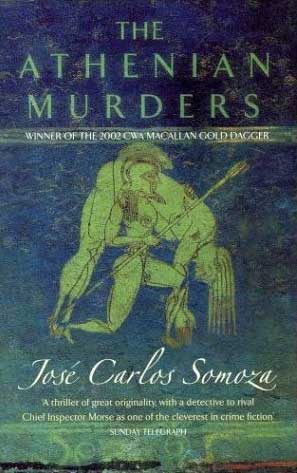.

Author José Carlos Somoza
Original title La caverna de las ideas
Translator Sonia Soto
Country Spain
Language Spanish
Genre(s) Historical novel, Mystery
Publisher Abacus
Released 2002
Media type Print (Paperback)
Pages 314 p. (paperback edition)
ISBN ISBN 0-349-11618-0 (paperback edition)
The Athenian Murders is a novel written by Spanish author José Carlos Somoza. Originally published in Spain under the title La caverna de las ideas (The Cave of Ideas) in 2000, it was translated into English in 2002 by Sonia Soto. The Athenian Murders is Somoza's first novel to be published in English.
Plot summary
Spoiler warning: Plot and/or ending details follow.
The novel interweaves two apparently disparate storylines: the first being an ancient Greek novel published in Athens just after the Peloponnesian War and the second contained within a modern-day scholar's notes on his translation. In the ancient novel (which is itself called The Athenian Murders) a young ephebe named Tramachus is discovered on the slopes of Mount Lycabettus, apparently attacked by wolves. His tutor at the Academy, Diagoras, enlists the help of a "Decipherer of Enigmas" (a detective named Heracles Pontor) to learn more about Tramachus's death. As Diagoras and Heracles investigate, more youths from the Academy are discovered brutally murdered. Their investigation takes them all over Athens, from mystery cult worship services to a symposium hosted by Plato.
Meanwhile, the translator (who is never named) provides frequent commentary on the work, especially as it appears to him to be an example of an ancient literary device called eidesis. Eidesis is the practice of repeating words or phrases so as to evoke a particular image or idea in the reader's mind. As the translator works on the novel, he soon deduces that the eidetic secret concealed within the novel is The Twelve Labors of Heracles, one labor for each of the twelve chapters of the novel. The translator becomes obsessed with the imagery, going so far as to see himself depicted within the ancient work.
Partway through the novel, the translator is kidnapped and forced to continue the translation in a cell. His captor turns out to be the scholar Montalo, whose edition of The Athenian Murders is the only surviving copy of the work. Montalo himself had obsessed over the novel, hoping to find in it a proof of Plato's Theory of Forms. He felt that should an eidetic text, such as this novel, evoke the same ideas in each reader it would then prove that ideas have a separate, independent reality. However, Montalo finished the translation only to discover that the book proved the opposite—that the book proved his (and the translator's) reality did not exist. The translator finishes the work only to have the same realization: that they themselves are characters in The Athenian Murders, which was written by a colleague of Plato named Philotextus as a way to incorporate Plato's theory of knowledge while criticizing the philosophical lifestyle.
Spoilers end here.
Characters in The Athenian Murders
In the ancient novel
- Heracles Pontor– A "decipherer of enigmas" whose name bears a strong similarity to a later detective, Hercule Poirot.
- Tramachus – A young student at the Academy whose mutilated body is discovered on Mount Lycabettus.
- Itys – Tramachus's mother and childhood love-interest of Heracles Pontor.
- Diagoras – A tutor of philosophy at the Academy who enlists Heracles Pontor to solve the case.
- Yasintra – A hetaera working in Pireaus.
- Ponsica – Heracles Pontor's slave and worshipper of the Sacred Mysteries
- Euneos and Antisus – Classmates of Tramachus at the Academy.
- Cantor – An errant philosopher who rejects Plato's rationality.
- Menaechmus – A sculptor and tragedian in Athens.
- Plato – A highly regarded philosopher at the Academy.
In the footnotes
The translator – An unnamed character who is only known through his footnotes to the translation of The Athenian Murders.
Helena – A colleague of the translator who correctly identifies the first eidetic message.
Montalo – The scholar who first compiled and annotated the papyri on which The Athenian Murders is told.
Platonic references
Spoiler warning: Plot and/or ending details follow.
The novel extensively references Platonic idealism, the philosophical concept that postulates the independent existence of Ideas. According to Plato, the realm of Ideas is the only true reality; our world is made up of imperfect, ephemeral imitations of the true ideas. The allegory of the cave also figures prominently: the epilogue penned by Philotextus states that he believes philosophers are the ones inside the cave, oblivious to the real (that is, material) world all around them.
The work also references Plato's Republic—the future world envisioned by Philotextus in which Montalo and the translator dwell is the ideal society postulated by Plato. In it, men and women are completely equal, violence has been eradicated, and the best of people rule the cities.
The novel also takes place in a number of locations significant to ancient Greek philosophy. Diagoras and Heracles often walk in the Poikile Stoa, the birthplace of Stoicism. The duo also attend a Platonic symposium at the Academy of Plato.
Links
| Ancient Greece
Science, Technology , Medicine , Warfare, , Biographies , Life , Cities/Places/Maps , Arts , Literature , Philosophy ,Olympics, Mythology , History , Images Medieval Greece / Byzantine Empire Science, Technology, Arts, , Warfare , Literature, Biographies, Icons, History Modern Greece Cities, Islands, Regions, Fauna/Flora ,Biographies , History , Warfare, Science/Technology, Literature, Music , Arts , Film/Actors , Sport , Fashion --- |
Retrieved from "http://en.wikipedia.org"
All text is available under the terms of the GNU Free Documentation License

